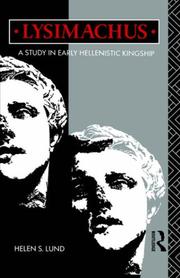| Listing 1 - 10 of 12 | << page >> |
Sort by
|
Book
ISBN: 9782503605326 250360532X Year: 2023 Publisher: Turnhout : Brepols,
Abstract | Keywords | Export | Availability | Bookmark
 Loading...
Loading...Choose an application
- Reference Manager
- EndNote
- RefWorks (Direct export to RefWorks)
Based on the evidence of epigraphic material in combination with monumental painting, this book explores important dedicatory inscriptions (9th-beginning of the 13th c.) from Macedonia and Thrace, which have so far been investigated mainly from a philological-historical standpoint, thus neglecting the major issue of Middle Byzantine patronage. Through patron inscriptions and textual sources, the role and the motives of military officials in the patronage of defensive and fortification works, and the manner of publicizing them, are examined systematically. Patronage is looked at through the ideological messages that the donors endeavor to promote in a local society or monastic community, and which echo their relationship with the state and their views on education and faith. The new interpretations presented in this book result from the collation of historical, prosopographical, archaeological and visual data, which offer valuable evidence about military patronage, the relation of the donation to the personal life of the donor and his family, the spiritual life of monasticism and the building complex of the monastery, and the relationship between inscriptions, space and iconography. Interesting methodologically is the co-examination of the various categories of inscriptions in combination with historical texts and donor portraits, which opens up new avenues of research for the study of the interdisciplinary material in question.0
Auftraggeber. --- Epigraphik. --- Stifter. --- Inschrift. --- Makedonien --- Thrakien. --- Byzantinisches Reich.
Book
ISBN: 9783805329743 3805329741 Year: 2003 Publisher: Mainz von Zabern
Abstract | Keywords | Export | Availability | Bookmark
 Loading...
Loading...Choose an application
- Reference Manager
- EndNote
- RefWorks (Direct export to RefWorks)
Thrakien gehörte de facto schon lange, bevor es im Jahre 44/45 n. Chr. den Provinzstatus erhielt, zum römischen Reich, indem die thrakischen Könige dem römischen Kaiser zum Gehorsam verpflichtet waren. Das Kerngebiet des thrakischen Königreiches und der römischen Provinz lag südlich des Balkangebirges, es reichte im Süden bis zum Thrakischen Meer und zum Bosporus, im Osten bis zur westlichen Pontusküste. Die Hauptstadt war Perinthos an der nördlichen Propontisküste (Marmarameer, heute Türkei). Seit dem frühen 2. Jh. n. Chr. entwickelte sich ein reges und blühendes st©Þdtisches Leben in Thrakien. Kaiser Traian gründete nach seinem Sieg über die Daker zwei Städte in Thrakien: Nicopolis ad Istrum (die Siegesstadt an der Donau) und Nicopolis ad Nestum (Siegesstadt an der Mesta). Seit dem 4. Jh. gehörte Thrakien zu den Kerngebieten des aufstrebenden oströmischen, später byzantinischen Reiches, dessen Hauptstadt Konstantinopel in der Teilprovinz Europa lag. In dieser Zeit strebten viele Frem dvölker - Germanen, Hunnen, Awaren, später auch Slawen - nach Thrakien. Im Jahre 378 kam es bei zu einer schweren Niederlage des römischen Heeres gegen die Goten. Die thrakischen Provinzen wurden nach Aufgabe des Limes an der unteren Donau um das Jahr 600 zur Grenzzone, verblieben aber unter oströmisch-byzantinischer Herrschaft.
Thrace --- Antiquities --- History --- Antiquités --- Histoire --- Antiquités --- Thrace - Antiquities --- Thrace - History - To 1362 --- Antiquities. --- To 1362. --- Mediterranean Region --- Thrakien. --- History.
Book
ISBN: 9783631344330 Year: 1999 Publisher: Frankfurt am Main ; New York : Lang,
Abstract | Keywords | Export | Availability | Bookmark
 Loading...
Loading...Choose an application
- Reference Manager
- EndNote
- RefWorks (Direct export to RefWorks)
Ethnic relations.
---
Fremdbild
---
Fremdbild
---
Islamieten.
---
Minderheden.
---
Minderheit
---
Minorities
---
Minorities.
---
Muslim
---
Muslims
---
Muslims.
---
Musulmans
---
Politics and government.
---
Selbstbild
---
Selbstbild
---
Selbstbild
---
Selbstbild
---
Muslim
---
Minderheit
---
Fremdbild
---
Fremdbild
---
Since 1974.
---
Athigani
---
Greece
---
Greece
---
Greece.
---
Pomaken
---
Thrace (Grèce)
---
Thrace, Western (Greece)
---
Thrakien
Book
ISBN: 9781887829823 1887829822 Year: 2011 Volume: 82 Publisher: Portsmouth, RI Journal of Roman archaeology
Abstract | Keywords | Export | Availability | Bookmark
 Loading...
Loading...Choose an application
- Reference Manager
- EndNote
- RefWorks (Direct export to RefWorks)
Excavations (Archaeology) --- Antiquities, Roman --- Fouilles (Archéologie) --- Antiquités romaines --- Congresses --- Congrès --- Thrace --- Antiquities --- Antiquités --- Ausgrabung. --- Funde. --- Römerzeit. --- Thrakien. --- Antiquities, Roman. --- Fouilles (Archéologie) --- Antiquités romaines --- Congrès --- Antiquités --- Congresses. --- Тракия --- Trakii︠a︡ --- Trakya --- Thrakien --- Thracia --- Tracia --- Thrakē --- Thráki --- Trakiya --- Θράκη --- Θρακη

ISBN: 8816950900 Year: 1992 Volume: 90 Publisher: Milano Jaca
Abstract | Keywords | Export | Availability | Bookmark
 Loading...
Loading...Choose an application
- Reference Manager
- EndNote
- RefWorks (Direct export to RefWorks)
Lysimachus, --- Greece --- Macedonia --- Thrace --- Grèce --- Macédoine --- History --- Kings and rulers --- Biography --- Histoire --- Rois et souverains --- Biographie --- Grèce --- Macédoine --- Trakii︠a︡ --- Trakya --- Thrakien --- Thracia --- Tracia --- Thrake --- Thráki --- Trakiya --- Biography. --- Тракия --- Thrakē --- Θράκη --- Θρακη
Book
ISBN: 3805304358 9783805304351 Year: 1980 Publisher: Mainz Zabern
Abstract | Keywords | Export | Availability | Bookmark
 Loading...
Loading...Choose an application
- Reference Manager
- EndNote
- RefWorks (Direct export to RefWorks)
archaeology --- goldsmithing --- Applied arts. Arts and crafts --- Archeology --- Thrace --- Art, Thracian --- Art thrace --- #BIBC:bibl.Reekmans --- -Trakii︠a︡ --- Trakya --- Thrakien --- Thracia --- Tracia --- Thrake --- Thráki --- Trakiya --- Antiquities --- -Exhibitions --- Thracian art --- Exhibitions --- Trakii︠a︡ --- Exhibitions. --- Expositions --- Antiquités --- Тракия --- Thrakē --- Θράκη

ISBN: 1280337052 020303404X 9780203034040 9780415070614 0415070619 9786610337057 6610337055 9781134911653 1134911653 9781134911608 1134911602 9781134911646 1134911645 9780415755856 0415755859 Year: 1992 Publisher: London New York Routledge
Abstract | Keywords | Export | Availability | Bookmark
 Loading...
Loading...Choose an application
- Reference Manager
- EndNote
- RefWorks (Direct export to RefWorks)
Although shortlived, Lysimachus' Hellespontine empire foreshadowed those of Pergamum and Byzantium. Lund's book sets his actions significantly within the context of the volatile early Hellenistic world and views them as part of a continuum of imperial rule in Asia minor. She challenges the assumption that he was a vicious, but ultimately incompetent tyrant.
Lysimachus, --- Lisimaco, --- Lizimakh, --- Lysimachos, --- Greece --- Macedonia --- Thrace --- Тракия --- Trakii︠a︡ --- Trakya --- Thrakien --- Thracia --- Tracia --- Thrakē --- Thráki --- Trakiya --- Θράκη --- History --- Kings and rulers --- Lysimachus --- Greece - History - Macedonian Hegemony, 323-281 B.C. --- Macedonia - History - Diadochi, 323-276 B.C. --- Thrace - Kings and rulers - Biography --- Θρακη

ISBN: 9004068848 9004295739 9789004068841 Year: 1983 Volume: 95 Publisher: Leiden : E.J. Brill,
Abstract | Keywords | Export | Availability | Bookmark
 Loading...
Loading...Choose an application
- Reference Manager
- EndNote
- RefWorks (Direct export to RefWorks)
Cults --- Moesia --- Thrace --- Religion --- -Cults --- -291.09398 --- Alternative religious movements --- Cult --- Cultus --- Marginal religious movements --- New religions --- New religious movements --- NRMs (Religion) --- Religious movements, Alternative --- Religious movements, Marginal --- Religious movements, New --- Religions --- Sects --- Religion Comparative religion Southeastern Europe --- -Thrace --- -Religion --- 291.09398 --- Trakii︠a︡ --- Trakya --- Thrakien --- Thracia --- Tracia --- Thrake --- Thráki --- Trakiya --- Mizii︠a︡ --- Mezija --- Μοισία --- Moisía --- Мизия --- Miziya --- Мезија --- Religion. --- Тракия --- Thrakē --- Θράκη --- Θρακη
Book
ISBN: 9781107030534 1107030536 9781139343817 1139611062 1107237556 1139625942 1139609270 1139616641 1139343815 1139612921 1139622226 1299405711 9781139625944 9781139612920 9781139611060 9781107237551 9781139609272 9781139616645 9781299405714 9781139622226 Year: 2013 Publisher: Cambridge Cambridge University Press
Abstract | Keywords | Export | Availability | Bookmark
 Loading...
Loading...Choose an application
- Reference Manager
- EndNote
- RefWorks (Direct export to RefWorks)
From the mid-sixth to the mid-fourth century BCE a nexus of connections to Thrace defined the careers of several of Athens' most prominent figures, including Pisistratus, Miltiades, Alcibiades and Iphicrates. This book explores the importance of Thrace to these individuals and its resulting significance in the political, cultural and social history of Athens. Thrace was vitally important for Athens thanks to its natural resources and access to strategic waterways, which were essential to a maritime empire, and connections to the area conferred wealth and military influence on certain Athenians and offered them a refuge if they faced political persecution at home. However, Thrace's importance to prominent individuals transcended politics: its culture was also an important draw. Thrace was a world free of Athenian political, social and cultural constraints - one that bore a striking resemblance to the world of Homeric epic.
Athens (Greece) --- Thrace --- Athènes (Grèce) --- Politics and government. --- Relations --- Politique et gouvernement --- Political science. --- Relations. --- Greece --- Mediterranean Region --- Athènes (Grèce) --- Arts and Humanities --- History --- Тракия --- Trakii︠a︡ --- Trakya --- Thrakien --- Thracia --- Tracia --- Thrakē --- Thráki --- Trakiya --- Θράκη --- Aḟiny (Greece) --- Atene (Greece) --- Atʻēnkʻ (Greece) --- Ateny (Greece) --- Athen (Greece) --- Athēna (Greece) --- Athēnai (Greece) --- Athènes (Greece) --- Athinai (Greece) --- Athīnā (Greece) --- Αθήνα (Greece)

ISBN: 0415070619 9780415070614 Year: 1992 Publisher: London Routledge
Abstract | Keywords | Export | Availability | Bookmark
 Loading...
Loading...Choose an application
- Reference Manager
- EndNote
- RefWorks (Direct export to RefWorks)
Greece --- History --- Macedonian Hegemony, 323-281 B.C. --- Macedonia --- Diadochi, 323-276 B.C. --- Thrace --- Kings and rulers --- Biography --- Lysimachus, King of Thrace, ca. 361-281 B.C. --- Greece - History - Macedonian Hegemony, 323-281 B.C. --- Macedonia - History - Diadochi, 323-276 B.C. --- Thrace - Kings and rulers - Biography. --- Lysimachus, --- Lisimaco, --- Lizimakh, --- Lysimachos, --- Тракия --- Trakii︠a︡ --- Trakya --- Thrakien --- Thracia --- Tracia --- Thrakē --- Thráki --- Trakiya --- Θράκη --- Biography. --- Lysimachus --- Grèce --- Macédoine --- Histoire --- Rois et souverains --- Biographie --- Thrace - Kings and rulers - Biography --- Θρακη
| Listing 1 - 10 of 12 | << page >> |
Sort by
|

 Search
Search Feedback
Feedback About UniCat
About UniCat  Help
Help News
News